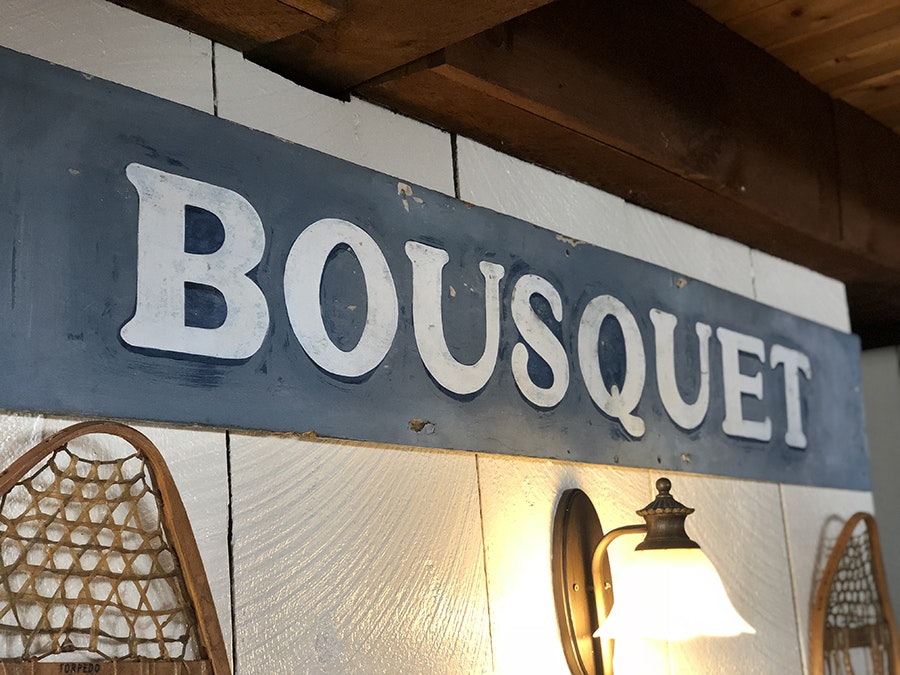Bousquet, Under New Ownership, Will Share a Pass with Berkshire East, Catamount
Posted on July 27, 2020Written by Jacob Hane
Updated on July 27, 2020

The $1 million sale to Mill Town Capital echoes Saddleback sale to investment group, crystalizes Berkshires’ status as the Northeast’s ski laboratory.
Stuart Winchester | originally posted by The Storm Skiing Journal and Podcast
 In the Bousquet lodge in 2019. This is probably not one of those stylishly weathered signs.
In the Bousquet lodge in 2019. This is probably not one of those stylishly weathered signs.
After more than a dozen years on the market, Massachusetts’ Bousquet Mountain sold late last week for just over $1 million, a touch more than the median price of a one-bedroom Manhattan apartment and a huge discount to the $3.2 million initial asking price in 2007.
The new owner is Mill Town Capital, a private investment group that you probably haven’t heard of. They are partnering with Berkshire East/Catamount owners Jon and Jim Schaefer, who, if you’re reading this, you probably have. Crucially, the ski area will share the $549 Berkshire Summit pass with the Schaefers’ other two Massachusetts properties.
The sale, to a community-oriented investment group of the sort that’s resuscitating Saddleback, is a jetbooster on a go-cart. A racing incubator, a town asset, a night-skiing pioneer, a stable Berkshires workhorse, Bousquet has nonetheless tottered along for years, a noble, ragged throwback that could use some Magic Mountain-style TLC.
They’re about to get it. Here are some initial thoughts on the sale and what it means for this Berkshires mainstay and its competitors:
Folding Bousquet into a multi-pass builds a powerful local ski area network in the Berkshires
The single-mountain season pass is an outmoded business model. Like payphones and straight skis, you still see them on occasion. But you won’t for long. As Vail and Alterra continue to expand, improve, and cheapen their offerings in the region, Northeastern ski areas, with a few exceptions, will have little choice but to band together and fight.
As far as platoons go, this isn’t a bad one to jump into the foxhole with. Berkshire East is the best pure skier’s mountain in Massachusetts, with the sort of interesting glade-and-bump terrain that is rare south of Vermont. Catamount, which the Schaefers acquired in 2018 after 40-ish years of successfully managing Berkshire East, delivers 1,000 vertical feet of varied terrain that is only getting better as they pump cash into trail, snowmaking, and chairlift expansions.
Bousquet sits between the two, an hour from Berkshire East to the north and 40 minutes from Catamount, perched atop the New York-Massachusetts border, to the south. This north-to-south spine creates the sort of regional density and variety that translate into a powerful pass sales incentive. Jon Schaefer told me last year on The Storm Skiing Podcast that dropping his two mountains onto a common pass had acted as an accelerant to sales, and while smaller, less interesting Bousquet does not have the same appeal to out-of-town day-trippers as the two larger mountains, it should nonetheless help boost the value and exposure of this growing Berkshires ski pass. Add in the fact that skiers can tack a $129 Indy Pass onto their Summit Pass, gaining two days each at Magic, Cannon, Bolton Valley, Black Mountain New Hampshire, and others in the region, and the odds in a deathmatch with Epik and Ikon passes starts to improve (I have not been able to confirm whether Bousquet will join the Indy Pass).
Bousquet is still selling a single-mountain pass for $359 ($89 for kids under 5; $180 for seniors). While this low cost is very in line with what I think Northeast mountains will eventually value their single-mountain passes at, I don’t frankly see the point of it in this case. Sell the ecosystem. Sell the variety. Sell the Hell-yeah-Berkshires localism for the brand that it is. Sell the hell out of the Summit Pass.
The banding together of these three mountains may nudge the other western Massachusetts ski area operators to finally acknowledge the inevitable and start lashing their properties together on a common pass. While the Murdock family’s $299 Butternut and $159 Otis Ridge passes are already affordable and may benefit less from such a combination, the Fairbank Group’s $869 Jiminy Peak season pass costs almost as much as an Epic Pass and is completely segregated from the operator’s other two mountains, Bromley (Vermont), and Cranmore (New Hampshire). Why they don’t fold these assets together and use their power of scale to sell more passes is one of the great mysteries of Northeast skiing.
And why not get everyone in a (probably virtual) room and talk about a larger Berkshires pass? That these three mountains now share a common pass but not common ownership demonstrates that such coalitions can function on a local scale. It’s worth investigating.
Engaging the Schaefers was a crucial first step toward long-term viability
The Schaefers “will advise Bousquet on capital and operational decisions and investments,” according to Mill Town’s press release. This is crucial. While there are certainly people who don’t come up running ski areas that end up very successfully running ski areas (see Sugarbush under Win Smith), there are many who blow it as well (see Jay Peak and Burke under Ariel Quiros). It’s best to find someone who knows what the hell they’re doing.
The Schaefers certainly know what the hell they’re doing. Roy Schaefer raised his kids on Berkshire East, and the place is a decades-long testament to the power of patience, frugality, persistence, creativity, and hands-in-the-snow grinding to turn a questionable venture into a thriving business.
When Jon assumed day-to-day operations from Roy sometime in the mid-2000s, he rapidly built out the summer operations and otherwise began modernizing the place, and then applied that same template to Catamount, adding lifts and ramping up the snowmaking capacity. The change was rapid, obvious, impactful, and indicative of the family’s long-term commitment to creating and maintaining outstanding recreational facilities.
Bousquet is a great little hill. Its rich history includes whistle-stop status on the famed 1930s New York City ski trains and a race team that’s churned out five Olympians. Claiming 750 vertical feet and 200 acres, it feels and skis much smaller, but that manageable size, combined with the gentle terrain, adds up to a perfect family hill.
But the place could use some work. The lifts, mostly old doubles, could probably use some updates, replacements, or reinforcements. There appear to be trail network expansion opportunities. And the snowmaking plant could use a boost. I expect the Schaefers, who are, incidentally, playing a similar advisory role at the revitalized private Hermitage Club, to quickly assess the needs and recommend a massive overhaul. And I expect Mill Town to say, “Yes, people who understand how to make skiing work in Massachusetts, let’s do exactly whatever you say.”
The Mill Town purchase fills another beaker in the investment-group-as-ski-area-owners laboratory
When Arctaris Impact Fund closed on stately and defunct Saddleback, Maine, earlier this year with the intent to revitalize the ski area, Outside described the purchase this way:
Arctaris’s Saddleback bid typifies an investment model that’s mushroomed since the term “impact investing” was coined in 2007 to describe funds seeking to effect social change as they make money. The Global Impact Investing Network estimates that the market size boasts over $502 billion in such managed assets. As other funds fight climate change and advocate for clean water, Arctaris, founded in 2009, has instead helped create about 200 jobs on Washington’s Yakama Indian Reservation by expanding a fiberglass plant, and also reopened a defunct paper mill in Michigan. In Maine it hopes to breathe new life into the charming but financially challenged outdoor sports mecca that sits at Saddleback’s base—Rangeley, population 1,100—and indeed the whole of Franklin County, a sprawling expanse of piney forests, snowmobile trails, and killer fishing holes that sits two and a half hours north of the nearest major city, Portland, and is home to 30,000 people, precious few wine bars or yoga studios, and many, many moose.
While it is unclear to me whether Mill Town is an “impact fund” per se, the company describes itself in similar terms, focusing on “local entrepreneurs and businesses with scalable potential,” an interest in housing development and revitalizing neighborhoods, and support for community projects and nonprofits focused on sustainability.
Describing Bousquet as an “outdoor recreation asset” that can be “bolstered” is, by my interpretation, a way of saying there are better ways to make money off this thing. That does not mean breaking out the Vail cookie cutters and driving the price of a bowl of chili up to $25. A reimagining of the whole operation will probably be good for skiers, and in fact the $359 pass price noted above is already cheaper than the last posted price for a 2019-20 pass at the mountain, and the value of joining the Berkshires Summit Pass is substantial.
Long term, the Saddleback and Bousquet ownership models will provide important case studies for the viability of the fund-as-owner model in skiing. If they turn out to be here to strip mine an asset of its revenue a la old-line newspapers and then leave the thing in a field to die, then the Colorado-based ski conglomerates will only grow more influential and powerful. If they instead show an alternative to nurturing decrepit mountains into sustainable businesses, the fund-as-ski-area-owner could turn into a more broadly deployed model acting as an important check on industrywide consolidation.
Something is happening in the Berkshires. Pay attention.
The Berkshires ski areas are often overshadowed by their Catskills counterparts to the west and the larger Green Mountains to the north. There are numerous reasons for this, from ease of access to sheer mountain size to historic marketing budgets. But that dynamic may be changing as this funky little ski region embraces an ethos of rapid adaptation and change, becoming the Northeast’s incubator for all things experimental and transformative.
The area has, first of all, embraced local, small-area consolidation ahead of the rest of the Northeast. As the two-owners-one-pass model of the Berkshires Summit pass demonstrates, that does not have to mean common ownership, only a pivot from an everyone’s-a-competitor mentality to a what-the-hell-are-we-going-to-do-to-survive-when-a-pass-to-half-a-dozen-of-our-largest-competitors-is-$700 posture.
These creative combinations have been happening for a while. Jiminy Peak long ago purchased and then shuttered nearby Brodie. When Otis Ridge and Ski Blandford approached insolvency, the longtime owners of larger Butternut invested in both. While Blandford closed at the end of this past season, the willingness to lash together former competitors to maintain the integrity of the local ski community – and build a business – may have influenced the combination of Catamount and Berkshire East soon thereafter.
Meanwhile, Jiminy Peak, the Berkshire’s most high-profile mountain, runs an ongoing experiment in the viability of the expensive single-mountain season pass. With a large condo base and a well-developed, well-managed mountain, they have the necessary infrastructure to see if this will continue to work. My guess is that it won’t, but my guess is also that they won’t let it not work. In other words, long before that ship sinks, the Fairbank Group will find some way to glue the mountain together with their other holdings and create some kind of superpass, which they could very well open to other independents.
The Schaefers don’t look to be done yet, either. Could they continue their rapid expansion and purchase Blandford before it falls into neglect? Are they ramping up for a larger purchase in northern New England? A crown jewel like Jay Peak that could make them Peak Resorts Part II, but more ruggedly local and skier-focused? Could other local ski areas, seeing the success of the two-owners-one-pass model, ask to join the Summit Pass?
Conversely, are they moving too fast? In two years, the longtime Berkshire East owners have gone from oversight of one ski area to adding Catamount and taking consulting roles on two others. Scaling up quickly doesn’t always work out. Skiing is a slow, deliberate, seasonal business suddenly changing at the speed of New England weather.
This is a region rich in ski history. It is also stuffed with failed experiments. There are 172 lost ski areas in Massachusetts, at least 62 of them in the Berkshires, according to the New England Lost Ski Areas Project. Only a dozen functioning mountains remain in the entire state. Those that survive have certainly proven themselves, hacking out an existence in the vagaries of New England weather for decades. But new challenges keep arising, from climate change to the need to attract more diverse participants to the megapass meteor to the Covid shutdown and rapid adaptation plans. There is no one right solution here, but the Berkshires in particular is emerging as an area bursting with the creative risk-taking that will be needed to one by one meet these very different modern ski challenges.
The new ownership group of Bousquet, in their initial let’s-meet-the-public moment, have let us know that they have the mindset and the vision to meet this future, whatever it brings.
In Categories
More Posts

The Berkshires Blog
Reconsidering Norman Rockwell
Published in Fine Art Globe By Jody B. Cutler-Bittner The Norman Rockwell Museum provides scope vis-à-vis the reputation of an…
Read More
The Berkshires Blog
Forget Far Flung, Take An Intra-State Road Trip To The Berkshires
Published by Forbes J.Q. Louise, Contributor This is not a typical winter travel season. With so many people sticking close…
Read More
The Berkshires Blog
Combining Travel with Art: Art-Themed Road Trips
Published by wheretraveler, January 2021 By Meryl Pearlstein 1Berkshire Assisted New York and New England are especially rich in artists’…
Read More
The Berkshires Blog
This Gilded Age Mansion in the Berkshires Is the Perfect Setting for a Romantic Winter Getaway
Published by Travel and Leisure Alisha Prakash, Senior Digital Editor To visit the Blantyre, a Tudor-style estate tucked away in…
Read More